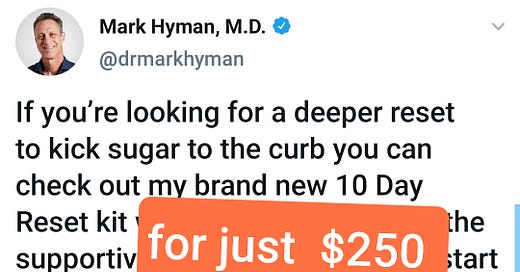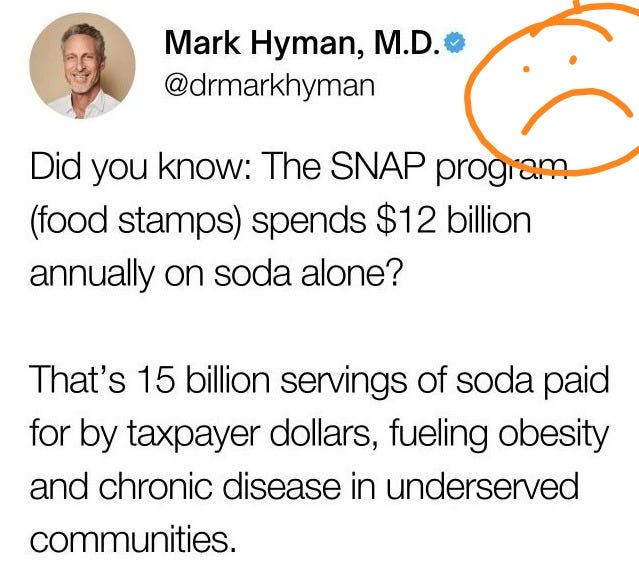🛒“The Grocery Cart” will start with the option of paid subscriptions in January. This means paid monthly or annual subscribers or those who earn free/comp months by referring people will have:
-the ability to see content just for PAID subscribers.
-the ability to comment.
-the chance to get a free ticket to Build Up Meet Up at FNCE 2025 in Nashville.
-the satisfaction of knowing they are supporting the work of Build Up Dietitians.
Hyman Hypocrisy
Supplement shill, friend of RFK Jr, Josh Axe, Dr. Gundry🦆🦆 ….we don’t expect much from Dr. Hyman, but this post definitely needs some context and explanation. (This is not to say we have an interest in encouraging soda consumption…we just prefer facts over misinformation.)
How accurate is this?⬇⬇
TL;DR - “SNAP” (Supplemental Nutrition Assistance Program) or formerly referred to as “Food Stamps”, doesn’t “spend” $12B on sodas. SNAP is a program that supplies supplemental funds to low-income participants to purchase foods/beverages and this helps with food insecurity. Participants have to meet certain guidelines to be accepted and receive these benefits and are able to choose what foods/beverages/products within specified categories. There is no proof/research that SNAP participants who purchase sodas/sweetened beverages with their SNAP funds experience obesity or diseases that can solely be attributed to sodas. . (Note: SNAP and WIC are NOT the same program!).
Who are SNAP recipients?
SNAP recipients are not homogenous, some are unemployed and some are employed. In FY 2022, 26% of SNAP households had earned income; among households with children, 50% had earned income.
Why Have SNAP?
Receiving SNAP can help improve food security and free up funds for other food expenses as well as housing, transportation, health care, clothing etc. SNAP is not meant to pay for all of a participant’s food costs - hence the term “supplemental”.
What Can be Purchased with SNAP?
Participants who receive SNAP can spend funds as they wish, with certain limitations:
SNAP benefits can be used to buy most groceries for household use, including breads and pastries; meats, poultry and fish (but not, in most cases, live animals and birds); fruits and vegetables; dairy products, including ice cream; and snack foods such as cookies, cakes and soft drinks. Recipients can also use SNAP benefits to buy plants and seeds to grow food for the household, but not (for example) non-edible flowers.
Alcoholic beverages and tobacco products cannot be bought with SNAP benefits, nor can nutritional supplements, medicines or pet food. Foods that are sold hot (think rotisserie chickens or ready-to-eat soups) aren’t eligible either, nor are household goods such as paper towels, cleaning products and toiletries. Gasoline isn’t eligible either. **Note: In times of disaster states can authorize use of SNAP benefits to purchase hot/prepared foods. What the data says about food stamps in the U.S. | Pew Research Center
SNAP by the Numbers*
💸$112.8 Billion - What the US Government spends on SNAP.
In 2023 the amount spent on SNAP (Supplemental Nutrition Assistance Program) by the US government was $112.8 Billion. “About $107 billion, or nearly 94 percent of SNAP spending, went directly to benefits that households used to purchase food. About 6 percent of SNAP spending in 2023 went to state administrative costs, and less than 1 percent of SNAP spending went to federal administrative costs.”Policy Basics: The Supplemental Nutrition Assistance Program (SNAP) | Center on Budget and Policy Priorities
🤼41.9 Million - How many people in US receive SNAP benefits
In 2023 an average of 41.9 million people (22.1 million households) received SNAP benefits. This represents 12.6% of the US population.
💳$212/month - An average that one person receives in SNAP benefits/month.
A single person receives an average of $212 per month or $7/day.**Note there is state-level variability in this amount. USDA ERS - Key Statistics and Research
10% of $107 B or $10.7B/year or $892M/month - SNAP funds spent on sodas and sweetened beverages.
🛒It’s estimated that 10% of SNAP benefits are spent on soda & sweetened beverages (this could also be sweetened fruit drinks (this was from a 2018 NPR article quoting a 2016 USDA report). That's approximately $10.7B per year or $892M per month that is spent out of SNAP benefits on sodas or sweetened beverages.
🥤$0.71 per day on Sodas or Sweetened Beverages
If 41.9 M people receive SNAP benefits per month, and $892M (per month) is potentially spent on sodas and/or sweetened beverages, that means that a participant might spend $21.29 per month on sodas (or other sweetened beverages). So approximately $0.71 per day may be spent on sodas (or other sweetened beverages) per SNAP participant.
A few things about SNAP:
From a 2016 report (the latest seemingly available):
🌟🌟“There were no major differences in the expenditure patterns of SNAP and non-SNAP households, no matter how the data were categorized. Similar to most American households.”:
🥖🧀🥩🍓🥦🥛🍳About 40 cents of every dollar of food expenditures by SNAP households was spent on basic items such as meat, fruits, vegetables, milk, eggs, and bread.
🍭🥨🥤Another 20 cents out of every dollar was spent on sweetened beverages, desserts, salty snacks, candy and sugar.
🍚🥣The remaining 40 cents were spent on a variety of items such as cereal, prepared foods, dairy products, rice, and beans.” Foods Typically Purchased by Supplemental Nutrition Assistance Program (SNAP) Households
(Caveat: Purchases made at other SNAP-authorized retailers or other venues (e.g., farmers markets) were not included in these data)
🎈🎈🎈
Bottom Line(s):
It does us no good to spread or share inaccurate or exaggerated narratives about food policy as Hyman has done here, and it would seem that shopping habits of non-SNAP recipients are very similar, so this isn’t a SNAP exclusive issue.
1.It would be helpful to see more current data and research on SNAP and health outcomes before you start trying to make correlations between soda and obesity for SNAP participants. Much of the data on obesity and health outcomes seems to be based on a report from 2007 and the information from a 2016 report.
2.Where are these participants able to spend their SNAP funds? i.e. do they have access to supermarkets or only convenience stores? Do they have farmers markets that accept SNAP? This will certainly have an effect on their food options and choices, especially perishable items.
Lastly, these are important points and reactions to Hyman’s post:
Orville Bigelow, MHSc, MS, RD: “I want to believe that his intentions are good, but his narrative is misleading and misguided. It's distorted talking points like this that mobilize people to defund important programs like SNAP…”
Caitlyn Shoemaker, MS, RDN, LDN, CDN, EDRC, CEDS: “The amount of fatphobia and weight stigma this man has (and the amount of healthism he perpetuates on his platform) is in itself disgusting. I would urge Mark Hyman to try and live on $5-10 per day and feed himself and then revisit his comments. This is not about soda. This is about white supremacy, patriarchy and healthism- shaming people for food choices when they may not actually have a choice because of time, resources etc does not solve the problem. It’s small minded.”
🙏🏽Thanks so much for reading…this won’t be the format for most of the newsletters - this is more like a rant…but sometimes rants serve a purpose.
Please consider pledging or subscribing! - Leah McGrath, RD, LDN







I do agree there are those who spread misinformation, however, I'm not comfortable with the comment at the end of the article by the dietitian stating this is a white supremacist situation or comment without there being data presented showing the numbers of those benefiting from snap who fit into different race categories. I personally worked in an area where the majority of the low income families were white and the majority of those that I saw using their SNAP cards were purchasing foods that were not nutrient dense and health benefiting -- was that more of an exception based on location and the population? Perhaps? Possibly? I feel like Hyman did not present accurate information, but I also think the comment on "white supremacy" is not relevant to the point of the article.